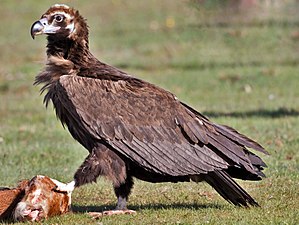Black vulture
| Black vulture | ||||||||||
|---|---|---|---|---|---|---|---|---|---|---|

Black Vulture ( Aegypius monachus ) |
||||||||||
| Systematics | ||||||||||
|
||||||||||
| Scientific name of the genus | ||||||||||
| Aegypius | ||||||||||
| Savigny , 1809 | ||||||||||
| Scientific name of the species | ||||||||||
| Aegypius monachus | ||||||||||
| ( Linnaeus , 1766) |
The Mönchsgeier or cowl Geier ( Aegypius monachus ) is a bird art that the Old World vultures belongs (Aegypiinae). With a length of over one meter, it is the largest bird of prey in Europe, alongside the bearded vulture, which is roughly the same size . It breeds mainly in wild mountain forests and in Europe occurs almost exclusively on the Iberian Peninsula , Mallorca and the southern Balkan Peninsula . No subspecies are distinguished.
features
The black vulture reaches a body weight of 7 to 12 kg and a wingspan of 250 to 295 cm, making it one of the largest species of vulture. It has a plain, dark brown plumage that looks black from a distance. His short, bare, bluish-pink neck is surrounded by a dark ruff of feathers. The wings are broad, the tail is often slightly wedge-shaped.
Occurrence
The black vulture is common in southern Europe and central Asia. Today it can be found from Spain via the Balearic Islands , the Balkans, Western Asia and northern India to southern Siberia, northern China and Mongolia. Wintering quarters are also further south, for example in Sudan, the Middle East, northwest India, Pakistan and Korea. In southern Europe the adults do not migrate in winter, in Asia especially those of the northern populations move to more southern regions in the cold season. The species used to be widespread in Morocco, Portugal, Italy, Ex-Yugoslavia, Albania, Romania, Moldova and Israel, where it is no longer found today.
The black vulture is considered "potentially endangered" according to the IUCN . According to experts from the Monfragüe National Park in Spain, where the largest colony in Europe is located, its population is dwindling, so that its classification as an "endangered species" is foreseeable. In Europe in particular, it has become rare in many parts of its original range or has already completely disappeared. In Spain, however, the population has recently recovered from 200 breeding pairs in 1970 to almost 1000 in 1992. On Mallorca there is a nature conservation organization for the conservation of the black vulture. She runs counts and catches young black vultures in order to relocate them to southern France or northern Macedonia . Since 1966, the number of black vultures on the island has increased from around 20 to 57 animals in 1991.
In addition, small remnants of the black vulture can be found in Europe in Greece (approx. 16 pairs), Bulgaria (1 pair), on the Crimean peninsula (3–6 pairs) and in the European part of Russia (approx. 50 pairs). Little is known about the stocks in Asia. In the Asian part of the former Soviet Union there are probably more than 1,000 couples. The IUCN estimates the total population at 7,200 to 10,000 pairs.
The habitat of the black vulture is mainly wooded hills and mountains, but in search of food it also often flies over open terrain. In the Monfragüe National Park in Spain, it has been observed that the black vulture is increasingly being displaced by griffon vultures that occupy its nests.
nutrition
The black vulture feeds primarily on the carrion of large and medium-sized mammals. Occasionally, especially in summer, when there are fewer carrions, it also kills smaller prey such as lizards and turtles, but also hares and similarly large mammals such as young ungulates. The great vulture is usually the dominant species of vulture on the carcass. Thanks to its extremely powerful beak, it can eat very tough parts of food such as muscles, tendons and skin, and it also cranks small bones.
Black vulture from: Johann Friedrich Naumann , Natural History of the Birds of Central Europe , 1905.
Black Vulture in the Tierpark Berlin
literature
- Josep del Hoyo , Andrew Elliot, Jordi Sargatal : Handbook of the birds of the World. Vol. 2: New World Vultures to Guineafowl. Lynx Edicions, Barcelona 1994, ISBN 84-87334-15-6 .
Web links
- Aegypius monachus in the endangered Red List species the IUCN 2008. Posted by: BirdLife International, 2008. Accessed January 31 of 2009.
- Videos, photos and sound recordings of Aegypius monachus in the Internet Bird Collection
- Black vulture's feathers
Individual evidence
- ↑ Thomas Urban , Geier gegen Geier , in: Süddeutsche Zeitung , December 12, 2018, p. 16.
- ↑ Thomas Urban , Geier gegen Geier , in: Süddeutsche Zeitung , December 12, 2018, p. 16.







